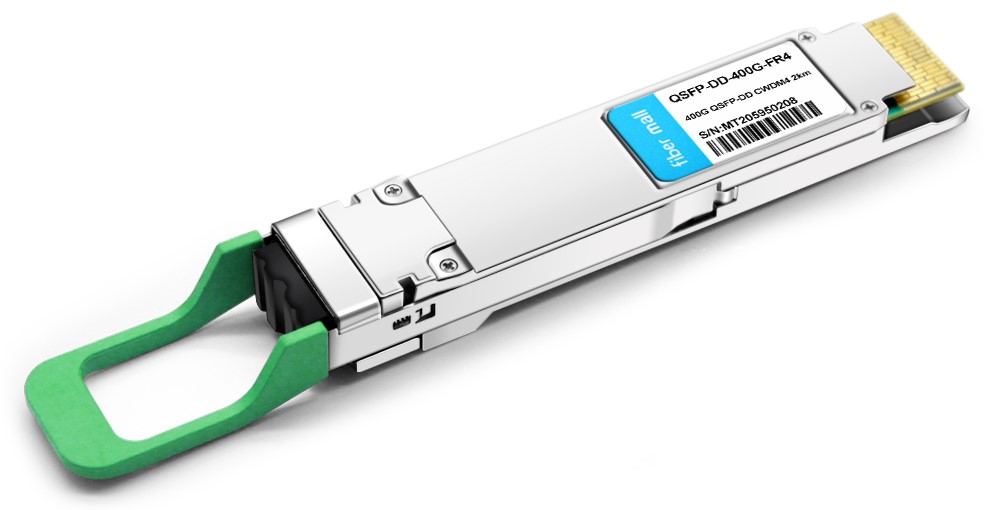

Sort by :Price: Low to High
Categories
{{cate.name}}
view {{page_size}}
400G QSFP-DD transceivers: SR8 vs DR4 vs FR4 vs LR4 vs LR8 vs ER8
The 400G system can further improve the network capacity and reduce the transmission cost per bit on the basis of the 100G system, effectively reducing the pressure of continuous growth of business traffic faced by operators. This article will introduce the different types of QSFP-DD optical transceivers in detail and analyze the differences between OSFP and QSFP+/QSFP28/QSFP56.
The QSFP-DD (Quad Small Form-factor Pluggable Double Density) is forward and backward compatible with the QSFP port and is also compatible with the existing QSFP28 optical modules and AOC/DAC, etc. With NRZ modulation technology, the data rate can be achieved for 200G( 25Gx8 channels) network transmission. Meanwhile, with PAM4 modulation technology, the data rate can reach 400G( 50Gx4 channels) network transmission for high-performance computing data centers and cloud networks. As the best option for the 400GE optical transceiver form factor, this QSFP-DD connector enables data centers to effectively grow and expand cloud capacity as needed.
· 400G SR8 QSFP-DD
The transmission distance of the 400G SR8 module through multimode fiber can be up to 70m on OM3 fiber or 100m on OM4 fiber. The transmission rate is up to 425Gbps and the central wavelength is 850nm. 400G QSFP-DD SR8 optical module is more suitable for short-distance interconnection or multi-channel data communication.

· 400G DR4 QSFP-DD
400G DR4 module achieves the transmission over SMF(single-mode fiber) with an MPO-12 connector. It supports a max transmission distance of 500m on single-mode fiber. In addition, 400G DR4 is also the base form of 400G silicon optical modules. In the 400G era of the data center, 400GBASE DR4 can not only realize the four-in-one Breakout networking, which can be transmitted to 100G DR1/FR1, but also replace the short-range multimode 400G optical module interconnection on the access side, with end-to-end cost competitiveness.
Plus, there’s an exclusive type similar to DR4 which is called the 400G XDR4 QSFP-DD module. The 400GBASE-XDR4 (extended reach DR4) transceiver, up to 2km over parallel SMF. The 400G XDR4 can break out to 4 x 100G, and interop with 4 x 100G-FR QSFPs.
· 400G FR4 QSFP-DD
400G FR4 module supports link lengths of up to 2km SMF with duplex LC connector. This module uses CWDM (wavelength division multiplexing) technology, using 8 channels of 53Gbps PAM4 signals on the electrical side, and 4 channels of 106Gbps PAM4 signals on the optical side, which is twice the rate of the electrical side.

The transmitter unit of the module uses a 4-channel laser driver chip to drive 4 groups of TOSA to realize the electric/optical conversion, and the 4 optical signals with the center wavelengths of 1271nm, 1291nm, 1311nm and 1331nm are outputted after the conversion, and then a MUX couples these four groups of signals into one SMF.
· 400G LR4 QSFP-DD
400GBase LR4 fiber optic modules are designed with a built-in Gearbox chip that multiplex the two channels' electrical input data into single-channel outputs signal and then modulates it to the optical receiver end. Specifically, the DSP basis gearbox converts 8 channels of 25GBaud PAM4 signals into 4 channels of 50GBaud (PAM4) signals over an SMF (Singlemode Fiber) cable with duplex LC connectors. This 400G QSFP-DD LR4 transceiver product features FEC and full real-time digital diagnostic monitoring, supporting a transmission distance of up to 10km. It defines a 400 Gb/s PHY for operation on the four CWDM center wavelengths of 1271nm, 1291nm, 1311nm, and 1331nm.
Plus, there's an exclusive type similar to DR4 which is called the 400G PLR4 QSFP-DD module. The 400GBASE-PLR4 (Parallel Long Reach) transceiver, up to 10km over parallel SMF. And the 400G PLR 4 can break out to 4 x 100G, and interop with 4 x 100G-LR QSFPs.
· 400G LR8 QSFP-DD
The 400GBASE-LR8 module supports link lengths of up to 10km over a standard pair of G.652 single-mode fiber (SMF) with duplex LC connectors. It is compliant to IEEE 802.3bs protocol and 400GAUI-8/CEI-56G-VSR-PAM4 standard. The 400 Gigabit Ethernet signal is carried over eight wavelengths. Multiplexing and demultiplexing of the eight wavelengths are managed within the device.
· 400G ER8 QSFP-DD
The 400GBASE-ER8 module supports link lengths of up to 40km over a standard pair of G.652 single-mode fiber (SMF) with duplex LC connectors. It is compliant to IEEE 802.3cn protocol and 400GAUI-8, QSFP-DD HW Rev 5.1, and QSFP-DD CMIS Rev 4.0 standard. The 400 Gigabit Ethernet signal is carried over eight wavelengths: 1273.54nm, 1277.89nm, 1282.26nm, 1286.66nm, 1295.56nm, 1300.05nm, 1304.58nm, 1309.14nm. Multiplexing and demultiplexing of the eight wavelengths are managed within the device.
· 400G ER4 QSFP-DD
Similar to 400G ER8, the 400G ER4 module supports link lengths of up to 40km over a standard pair of G.652 single-mode fiber (SMF) with duplex LC connectors. But, the 400G ER4 QSFP-DD has only four wavelengths which are The central wavelengths of the 4 LAN WDM channels are 1295.56nm, 1300.05nm, 1304.58nm and 1309.14nm.
1) QSFP-DD vs OSFP
The QSFP-DD module is defined by the QSFP-DD MSA, while the OSFP module is defined by the OSFP MSA. The OSFP is slightly wider and longer than the QSFP-DD, and therefore takes up more PCB surface area of the switch. OSFP module can arrange 32 ports on each 1U panel of the switch, while QSFP-DD can arrange 36 ports.

Therefore, in terms of switch bandwidth capacity, QSFP-DD can provide 4 more ports. Moreover, QSFP-DD has backward compatibility with QSFP and QSFP28. From these two points of view, the future of the QSFP-DD transceiver module seems brighter.
2) QSFP-DD vs QSFP vs QSFP28 vs QSFP56
Although QSFP-DD and QSFP+/QSFP28/QSFP56 belong to the same QSFP package and have the same size, there are still some differences between them.
· Structure
The QSFP-DD module is equipped with an 8-channel electrical interface. Compared with QSFP+/QSFP28/QSFP56 which has only a 4-channel electrical interface, the number of electrical interface channels of QSFP-DD is doubled, which is also due to a row of additional conductive metal.
· Bandwidth&Application
QSFP-DD is generally used as the form factor of 400G transceiver and 400G high-speed cables (i.e. DAC and AOC), which is used for the interconnection of 400G data centers to solve the problem of mass data migration between data centers; while QSFP+/QSFP28 /QSFP56 are respectively used for the 40G/100G/200G optical modules and high-speed cables, and for 40G/100G/200G network interconnection.
· Compatibility
Because QSFP-DD is backward compatible, modules or connectors in QSFP+/QSFP28/QSFP56 form factors can be plugged into QSFP-DD ports. In contrast, modules or connectors in the QSFP-DD form factors cannot be plugged into QSFP+/QSFP28/QSFP56 ports.
From automated industrial production to vehicle networking, from enterprise networks to carriers, 400G optical communication already points to two application scenarios: one is a cloud computing center, and the other is a high-speed transmission link. To realize these application scenarios, mature technical support is required. Fiber Mall can provide you with 400G QSFP-DD full series optical modules, and ensure the stability of quality and supply.
5. The 400 Gbps Market is on the Rise
Dell'Oro Group has reported that demand for 400 Gbps routers is on the rise, driven by global demand for IP backbone network upgrades. In the first half of 2022, 400 Gbps router port shipments grew more than 140% year-over-year, and this momentum is expected to continue through 2026, with revenue growing from 15-20% of total router port revenue in 2022 to 30-35% in 2026.

The market opportunity of 400 Gbps router is approximately $17 billion over the five-year period from 2022 to 2026. The combined market opportunity for 400 Gbps and 100 Gbps routers is expected to exceed $36 billion. The Internet backbone/IP backbone upgrade is driving the demand for 400 Gbps routers. Dell'Oro expects that within the next five years, the majority of 400 Gbps router ports will be deployed in IP backbone networks and that 400 Gbps technology will lead the next phase of Internet backbone expansion.
Cloud service providers have taken the lead in adopting 400 Gbps routers, with large-scale deployment of backbone networks starting in 2021. Dell'Oro says cloud providers are scaling their network infrastructure faster than telecommunication service providers. However, the market opportunity generated by cloud service providers is relatively small compared with telecommunication service providers. Over the next five years, cloud service providers are expected to account for about one-third of the core router market.

Telecommunication service providers are also adopting 400 Gbps technology on a large scale to provide a wide variety of services by deploying 400 Gbps routers in different network topologies and a range of configurations. Telecommunication service providers have more mature networks and service offerings than cloud service providers. The demand drivers for telcos to deploy 400 Gbps routers in their networks vary due to the different network topologies and uses. Rather than obsoleting and replacing network equipment, telecom operators typically upgrade equipment and expand capacity over time as needed.
The main reason that network operators are adding 400 Gbps ports to their backbone networks is that by using the latest generation of high-capacity ASICs, 400 Gbps routers have higher per-port speeds and lower power consumption, which reduces the total number of ports required, thereby reducing chassis size and saving valuable rack space.
The increased speed per port also reduces the cost per bit of the port, since one 400 Gbps port typically costs less than four 100 Gbps ports. As a result, transitioning to 400 Gbps ports allows service providers to invest more economically and efficiently and reduce operating costs. Telecommunication service providers did not invest significantly in their core networks until 2021, even as traffic increased massively during the pandemic. But as the pandemic plateaued, traffic didn't drop to pre-pandemic levels. Dell'Oro says many service providers are investing in capacity expansion and adapting their networks to meet traffic growth. The demand for 400 Gbps routers is expected to grow rapidly over the next five years.

Rising Capacity Requirement
The deployment of 5G RAN is facilitating the rapid expansion of mobile networks, with a dual impact. First, mobile service providers need to expand their mobile transport networks and deploy 400 Gbps routers for this purpose. Second, 5G technology enables higher mobile Internet connection speeds, encouraging mobile network customers to consume data-intensive media content and driving up the network traffic of service providers.
The growth of bandwidth services is continuing to be driven by the hybrid office model and the online learning model brought on by COVID-19, which is also leading to an increase in network traffic. While broadband subscriptions are expected to decline as the epidemic slows down the return of office learning models, subscriber growth is accelerating from 2021 through the first half of 2022. Media content services offered by cloud service providers are also driving the increase in telecommunication service provider network traffic. Cloud-based video, music streaming, and gaming platforms require high-bandwidth Internet connections, which typically generate large networks of Internet traffic. Given the traffic growth in the global backbone, cloud service providers and telecommunication service providers will increasingly adopt 400 Gbps routers in the future in order to optimize network capacity for economic efficiency, which will transform the service provider router market and lead the next phase of backbone expansion.